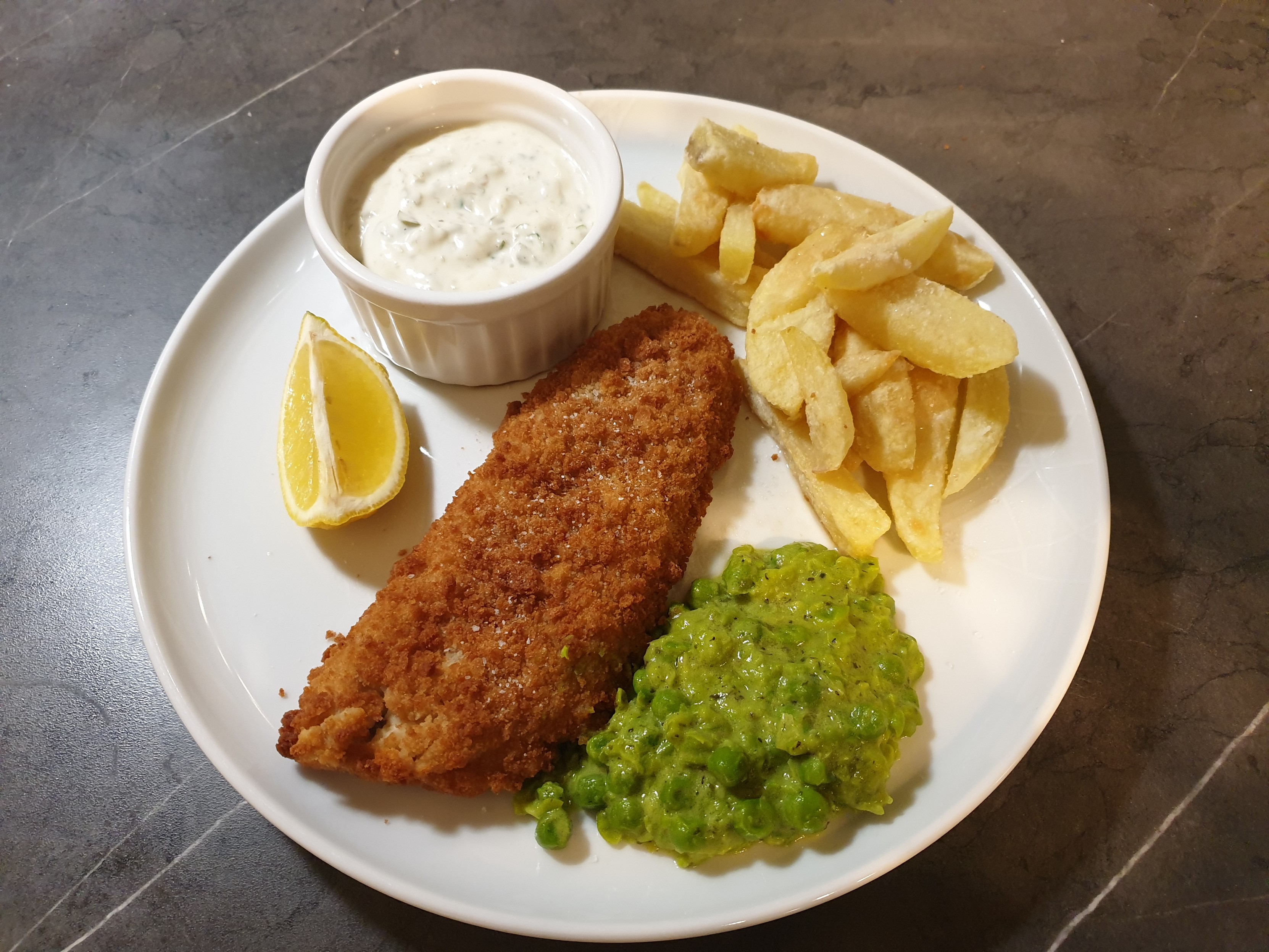Okay, kicking off my "traditional" British meals series with an obvious one - Friday night Fish and Chips, with homemade tartar sauce and mushy peas.
-
Brett Sheffield (he/him)replied to NeonSnake on last edited by
@neonsnake I don't ever recall my grandmother or mother making yorkshire pudding in the oven. It was basically a pancake cooked in dripping, the same size as the plate.
My grandparents had lived through the Depression and post-war rationing, so licking the plate clean was expected. When I later went to live with my father he beat that out of me rather quickly. "Etiquette! If you don't know what it means, go look it up in the dictionary!"

-
NeonSnakereplied to Brett Sheffield (he/him) on last edited by
@dentangle I wonder if that's a difference between typical kitchens? From memory, we'd use the oven much more than the stove (don't hold me to that, though)
Heh. My parents were both 1946 babies (Nan and Grandad evidently having, uh, somewhat missed each other whilst separated during the War...), so I had a mix. I definitely had to finish everything on the plate, but also was expected to be, I dunno, polite and well-mannered about it.
-
Brett Sheffield (he/him)replied to NeonSnake on last edited by
@neonsnake I vaguely recall my grandfather explaining that traditionally the pudding would be cooked in the dripping tray, though they never did that. They'd sometimes use a big electric fry pan with a lid for cooking the roast, perhaps because it was cheaper than running the oven.
When asked what was for dinner, he joke all I'd get was a "walk round table, laddie".

-
NeonSnakereplied to Brett Sheffield (he/him) on last edited by
@dentangle Yeah, I don't *think* I remember it ever being cooked in a pan underneath, but that's apparently the origin - I'm guessing that was back in the "cook the meat in an open hearth" days?
-
Brett Sheffield (he/him)replied to NeonSnake on last edited by
@neonsnake I guess so.
Damn all this talk of roasts and puddings. Hungry now.
-
From about 3lbs of beef (1.4 kg) for a cost of just shy of £15, I got - initially - four portions of roast dinner, 2 adult and 2 kids size.
The next day, I put the leftovers in the freezer for half hour, and then ran about half through a meat slicer, on about 2mm. From this, I made 4 portions of roast beef sandwiches, served on baguettes with rocket (arugula) and horseradish. The rest - about 3/4 lb (350g) I diced very roughly for stew (I got 4 good sized adult portions from it)
I have a large number of recipes for "meat and barley" stews - the one linked below uses swede rather than potato, but they're all similar. Use a small amount of meat, and stretch it using barley, vegetables, and flavour it with stock and herbs.
Meat, used frugally, and padded out with vegetables, herbs, spice, and broth, served with bread, is what used to be know as "pottage", the famously stereotypical dish of British peasants. All of the various dishes - be it the below, or Irish stew, or Scotch broth, or the others, are (as best as I can tell, and I'd love others' opinions) variants on pottage that have survived to modern day.
The one I made (beef with carrots, onions, potato and beef, with the barley) is known as "lobscouse", is a regional variant from Liverpool, and is why Liverpudlians are known as "Scousers".
Purists will say that it *has* to have carrot, potato and onion. I'm trying not to stray *too far* from the original dishes, but I also believe that as a "thrift" meal, adding swede instead of/as well as potato does not render it inadmissible.
I probably added more barley than is traditional, but, uh, I really like barley (some recipes don't use it at all, just the meat and vegetables)
During the cooking, if using potato but not, one would mash the potato a little once it's softened, and that would add as the thickener.
It's worth noting that as well as herbs like thyme, marjoram or rosemary - which would be available in many a kitchen garden, that it would be seasoned *heavily* with pepper (often white pepper, not black), which would give it a certain amount of heat. Without getting into the whole "spice" conversation right now, we did use more pepper than I think is generally understood, given that's what we had access to for everyday meals.
Beef & Barley Stew
Beef & Barley Stew Ingredients 60g pearl barley 250g leftover cooked beef, in 1/2inch chunks 1 tbsp olive oil 1 onion, finely chopped 2 cloves garlic, crushed 1 carrot, chopped roughly 100g swede, chopped roughly 700ml meat stock 1 tsp thyme/rosemary salt and pepper Directions Put the barley...
Google Docs (docs.google.com)
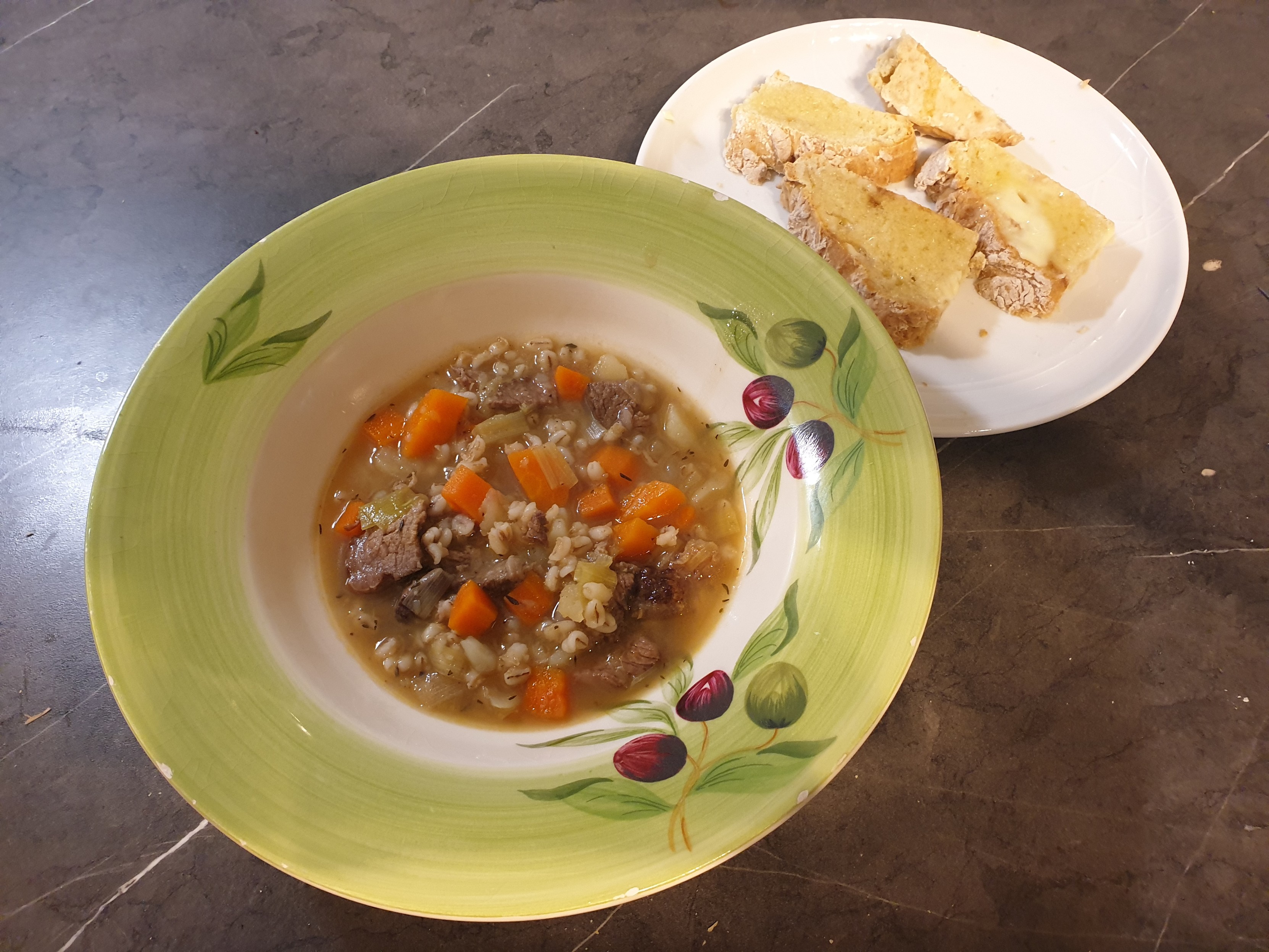
-
Brett Sheffield (he/him)replied to Brett Sheffield (he/him) on last edited by
@neonsnake We're having roast chicken cuisses with chips tonight. I have tried without success to convince my other half that I should be allowed to serve this on a yorkshire pudding with gravy

-
Toad In The Hole with Onion Gravy
Having spoken about Yorkshire Puddings yesterday, and with a half-dozen sausages on hand, I decided to make Toad In The Hole.
Again, it's not a particular mythical dish, with origins lost in the mists of time - it can be dated to roughly the late 18th Century, and is another way of stretching a small amount of meat.
Typically nowadays we use sausages, but all sorts of meat can be used - for instance, a cheap cut of beef, diced, was reasonably popular at the time.
I also made onion gravy - if you're vegan/vegetarian and miss gravy, I thoroughly recommend this. Whilst I've stuck with traditional ingredients this time, any umami that you want to add will work (Maggi liquid seasoning is a good one).
Other than the gravy, I served with swede & carrot mash as I had leftover swede, and peas to get some green on the plate.
Vegan sausages work in this very well.
(I've not personally made batter without milk and eggs, but I see no reason why it wouldn't be possible with something like oak milk and aquafaba)
Recipe links below:
Toad In The Hole
Toad In The Hole Ingredients 6 pork sausages 1 tablespoon groundnut oil 75g plain flour 1 large egg 75ml semi-skimmed milk 55ml water salt and freshly milled black pepper Directions Preheat oven to 220c Sieve the flour into a large bowl. Make a well in the centre, break the egg into it and ...
Google Docs (docs.google.com)
Onion Gravy
Toad In The Hole Ingredients 225g onions, peeled and sliced 2 tsp groundnut 1 tsp golden caster sugar 500ml vegetable stock 1 dsp Worcestershire sauce 1 tsp mustard powder 1 dsp plain flour salt and black pepper Directions Preheat oven to 220c Place the onions in a bowl and lightly ...
Google Docs (docs.google.com)
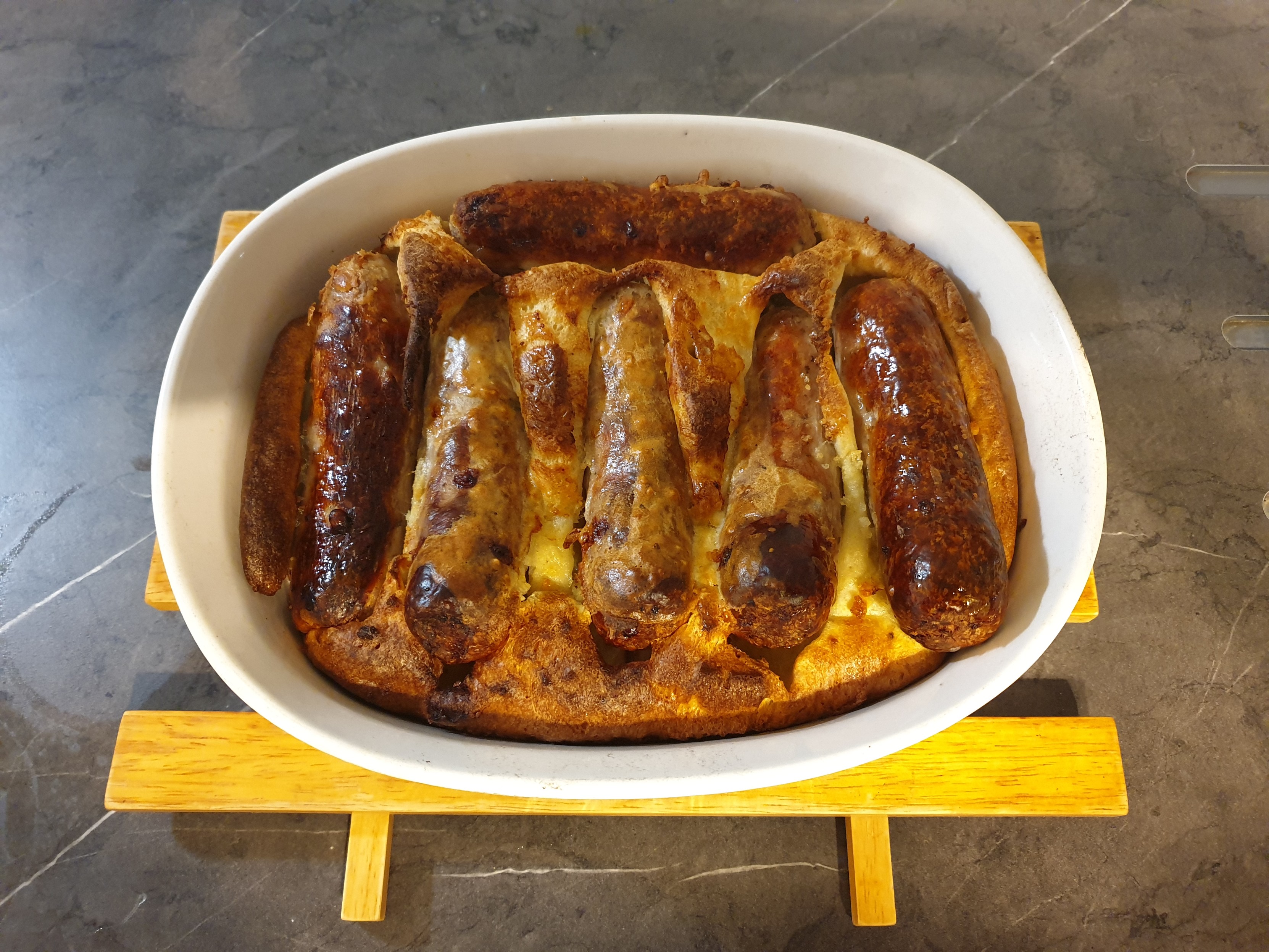
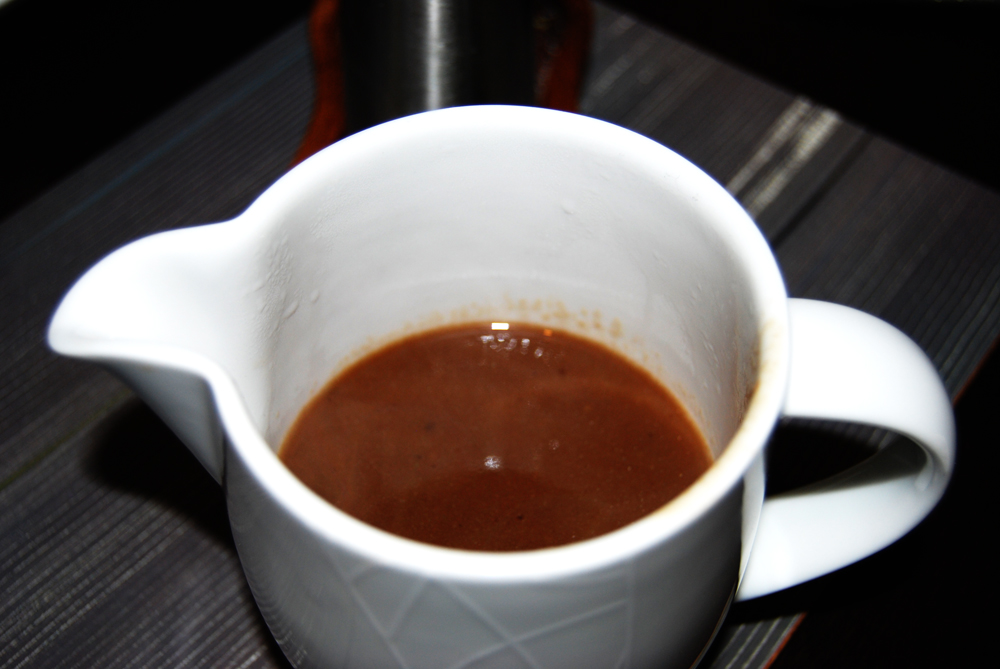
-
Ok, pies!
Pies are, of course, a quintessentially British invention. Apparently, 75% of the British population eat a pie once a month or more. Pies are very much associated with the working classes, and indeed a common football chant dating from the 1890s includes "who ate all the pies?" aimed at those deemed to be overweight through poor diet.
So British, in fact, that we, uh, had to send someone to Egypt in something like the 10th Century BC to invent them.
*cough*
Tongue now removed from cheek:
The earliest record we have of pies is in ancient Egypt, a pastry casing around a filling of honey, grains, and dried fruit or meat.
Records from 500 BC Greece and Rome have similar recipes.
Often the pastry casing was not intended to be consumed, but was intended to keep the filling fresh by protecting it from the air, and would be discarded. Think of it like a air-tight tupperware.
Over time, and as we get into the Middle Ages, the pie evolved. The casing became part of the meal itself, and the distinction between savoury and sweet became more distinct
Pies became on one hand, a way of showing off at expensive banquets ("four and twenty blackbirds"), but also still a way of stretching small amounts of meat for portable lunches.
I made here, a chicken and ham pie. Pie fillings have some regionality, this would be from Cornwall, roughly.
The meats were both cooked and leftover from previous meals. The pie filling is flavoured strongly with nutmeg and parsley, both commonly available, not expensive and by no means the exclusive province of the rich, as I want to start demonstrating the incorporation of herbs and spices into our meals. This is an easy start without suddenly moving from pottage to full-fledged spice mixes.
Chicken & Ham Pie
Chicken & Ham Pie Ingredients 30g butter (plus more for buttering the pie dishes) 1 leek, cleaned and sliced in half moons 30g flour 225ml milk 1 tsp mustard 150g cooked chicken, shredded 75g cooked ham, shredded or cubed 1 tbsp fresh parsley, chopped 1/4 nutmeg, grated 250g puff pastry (ready...
Google Docs (docs.google.com)
(I made it with mashed potatoes and peas, and leftover onion gravy that I made a couple nights back. I made it using a few of those rectangular tinfoil dishes to get the shape/portion size right, and because they're easy to take to other people - I got 4 portions from the recipe, and each "tin-sized" portion could arguably serve two people!)
I should and will note that "pies" are one of those dishes, like bread, that seems to appear in most cuisines that I know of across the world (in the sense of "a filling wrapped in a flour-based casing"), but I'm concentrating on British food right now.
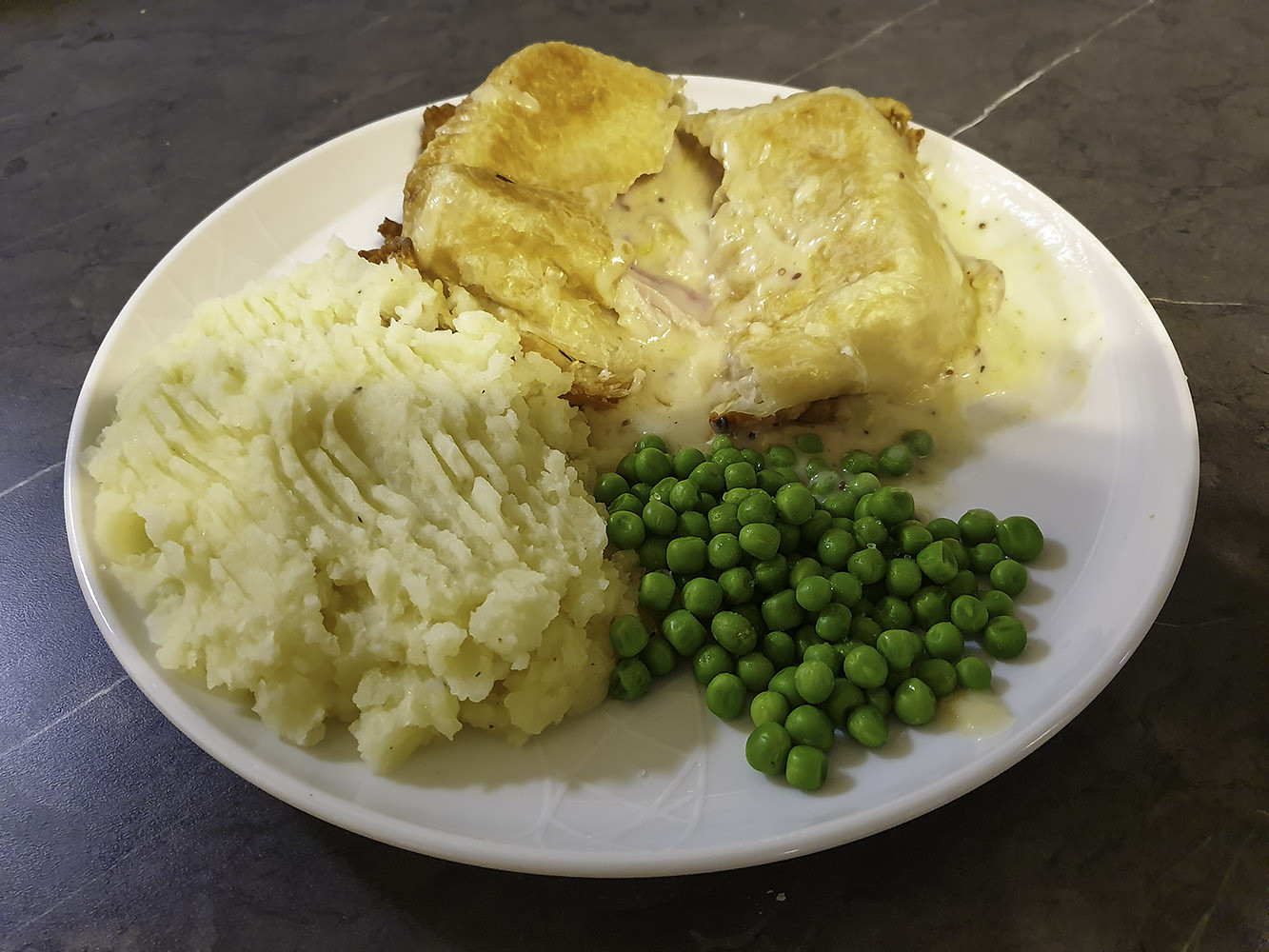
-
At the same time, I'm also doing some preserving, based on some older recipes I've found.
This one is salt beef, slightly distinct from my normal salt beef in that it's a drycure. Apparently it was popularly known as ""Spiced Beef" or "Huntsman's Beef", and was a breakfast dish eaten by people hunting away from home.
Now, I'm a little uncertain about the veracity of this. I regularly make salt beef, and my recipe is a *wetcure* of salt-petre, salt, sugar, juniper berries, black pepper and allspice (ie. the meat is covered by water with the spices mixed in, and then is cooked after a week or so in the cure)
This time, I'm attempting as mentioned, a drycure - the spices are exactly the same, just in slightly different proportions.
What I'm struggling to do is verify that this is genuinely a British dish - this isn't to ignore influences, at all, but normally I can at least have a stab at the history.
Here, I *think* this might primarily be a Pakistani dish, as most sources for "Hunters' Beef" bring up a version spiced with cumin, cinnamon and other Pakistani spices (and are labelled as "Pakistani Hunter's Beef"), so I'm unsure.
Obviously, with our history in the UK, colonialism plays a huge part, so it's hard to tell which way the "exchange" went, when it comes to food. Whilst I very much appreciate the "exchange", I also don't like to be able to fully understand the history, and on this one I'm not sure I do.
Either way, I'm going to give it a go. This needs to cure for a week or so, being turned every day, after which I will boil for a couple hours before slicing. The cure should mean that the cooked slices will last for a good few weeks in the fridge (as, in earlier times, they would last if taken out on the hunt)
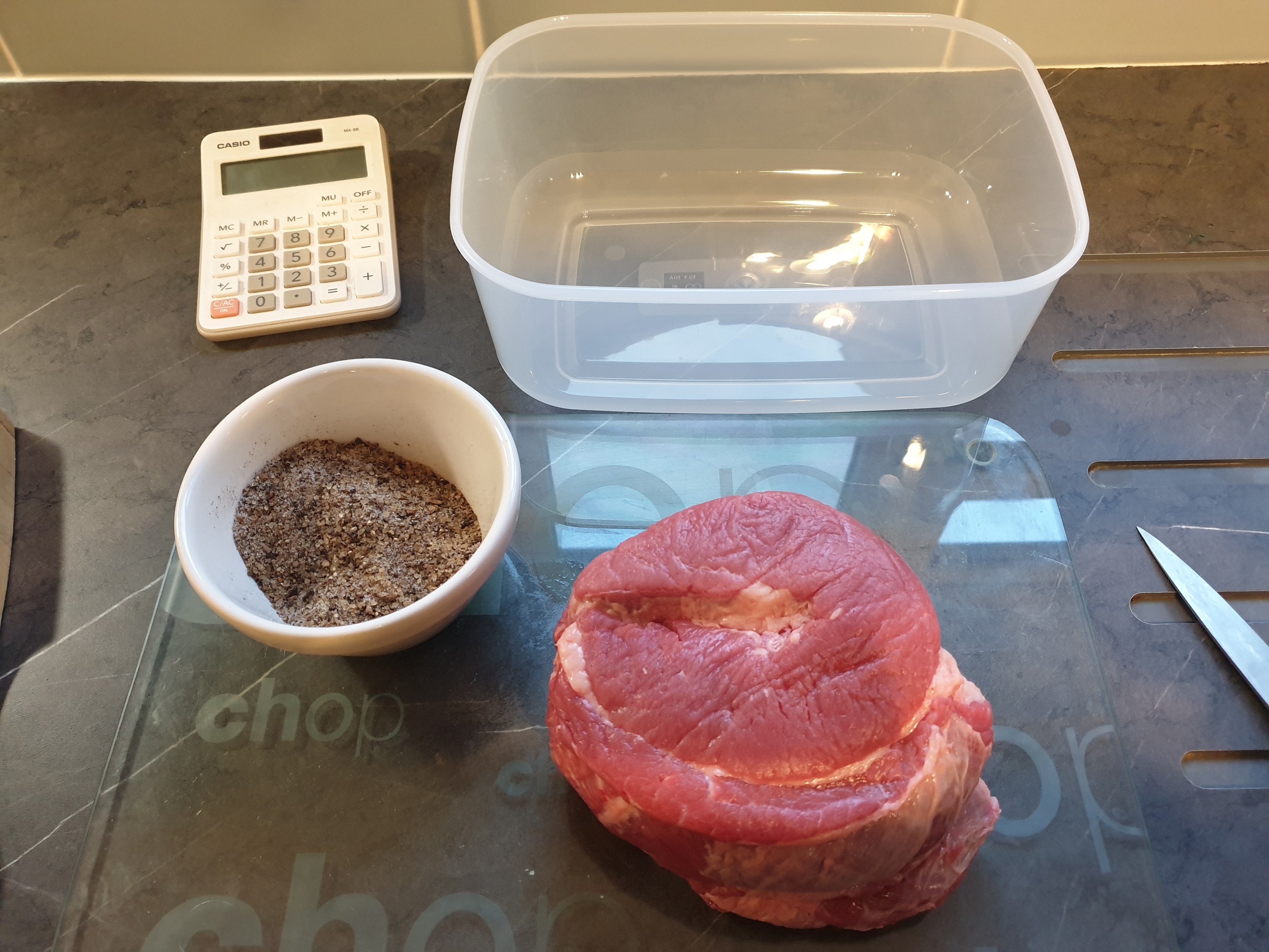
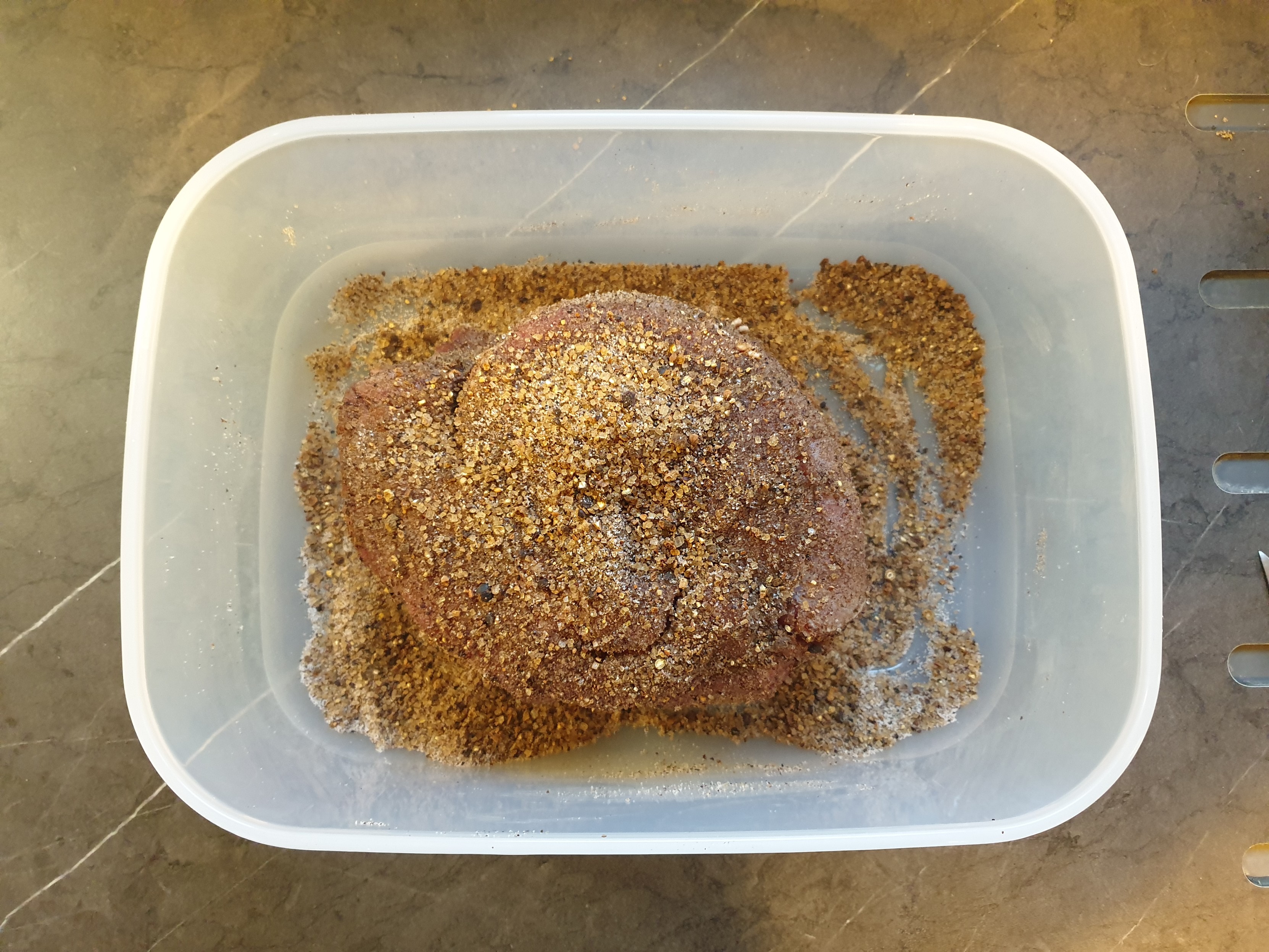
-
After nine days of curing, I'm ready to cook this.
I've taken a small amount off for tonight's dinner, which I'm going to cook separately, then re-tied the rest with kitchen string to hold the shape. I've rinsed the cure off, and it's now in the oven at 150c, in a covered casserole, with a cup of water, for 3 hours. I'll turn at 1 hr 30, but I'm hoping 3 hours should do it.
When I've done salt beef before, I've cooked it entirely submerged in liquid, so it will be interesting to see how this comes out with only a very small amount of liquid.
(I had a bit of a panic when I found the previous post and it said "6 days ago". Definite benefits of being able to check the meta-data on my earlier photo, plus checking back through my bullet journal to confirm that I originally put it in the cure on the 10th!)
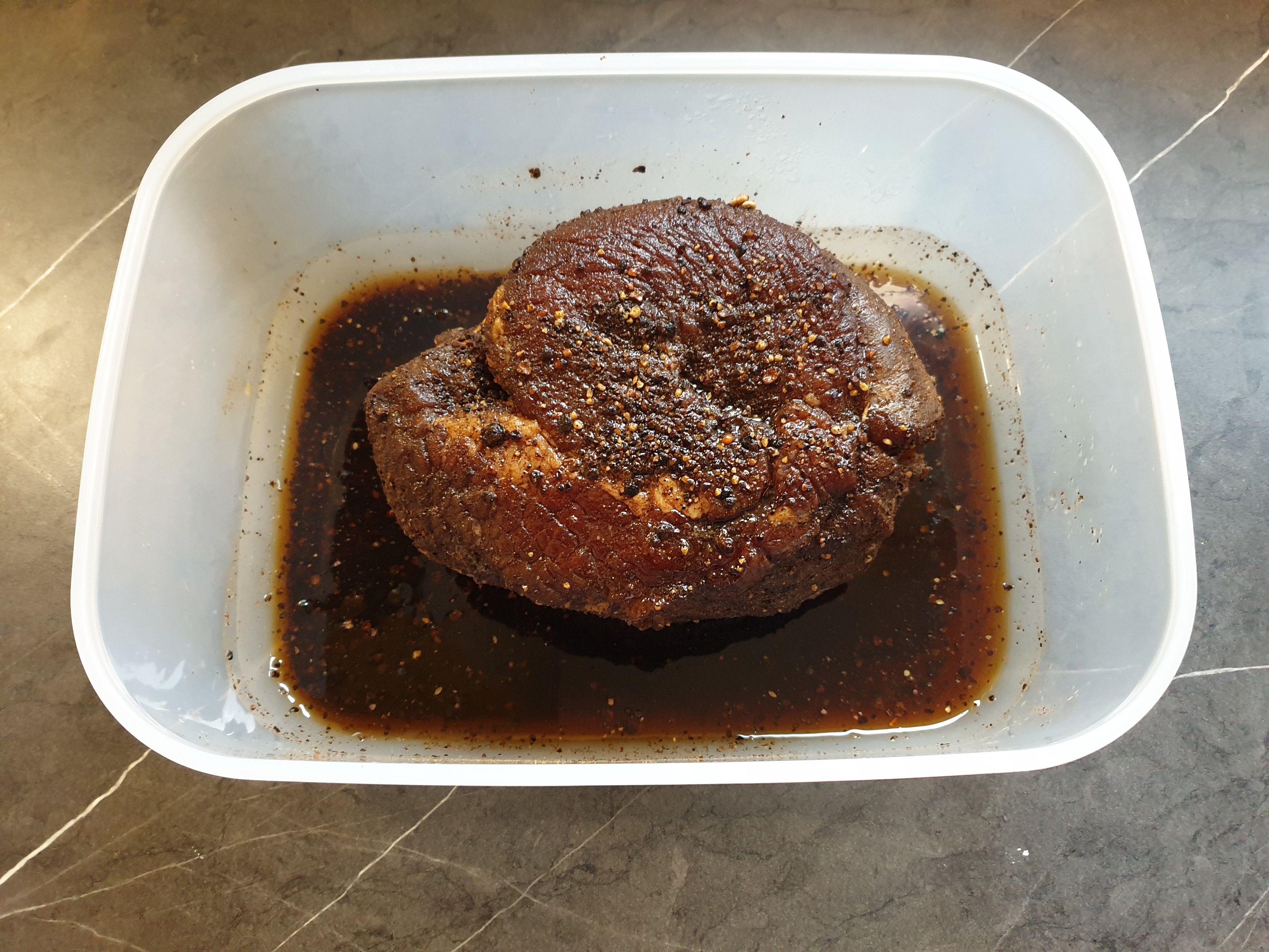
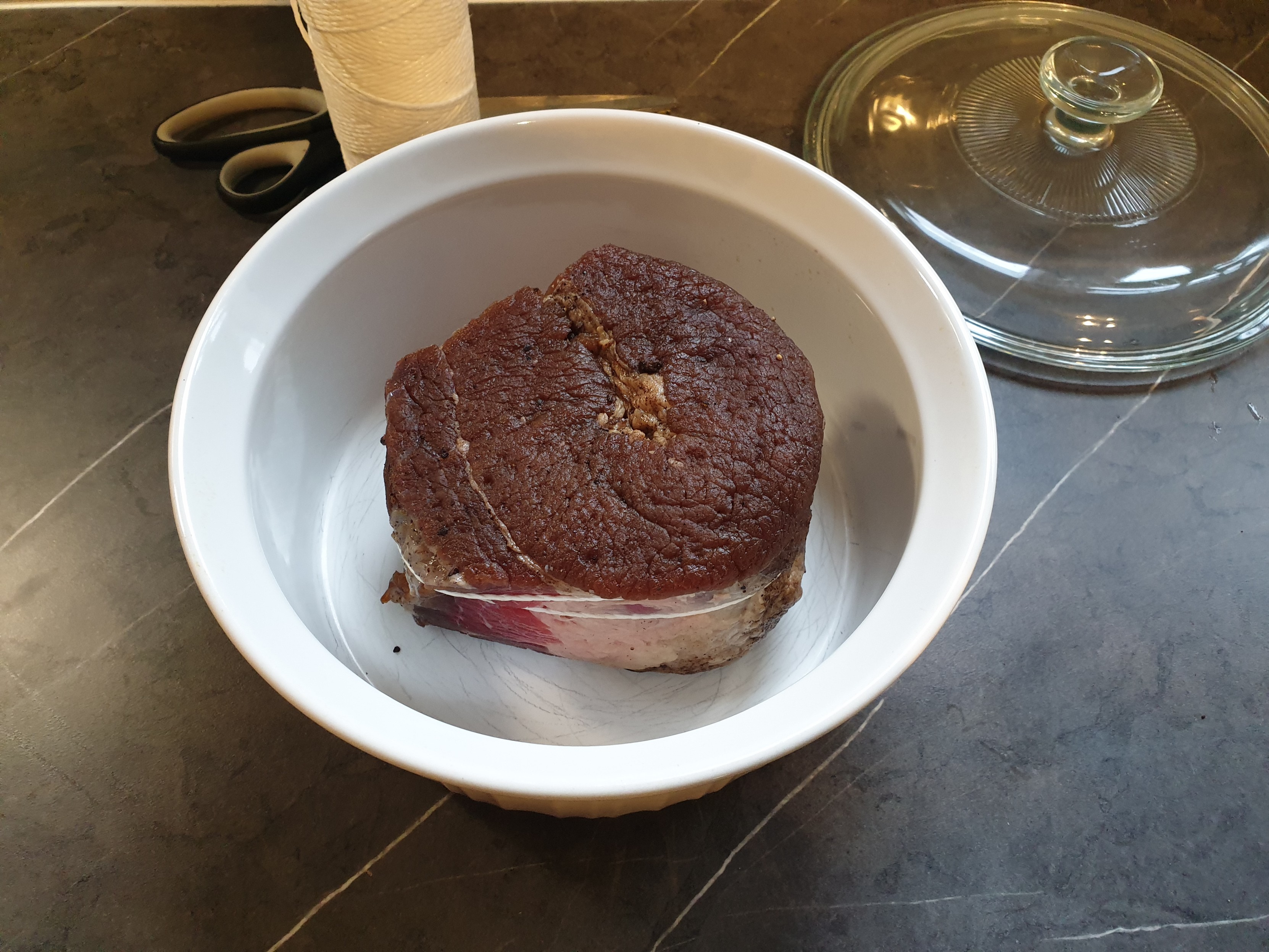
-
Brett Sheffield (he/him)replied to NeonSnake last edited by
@neonsnake If I could get there I'd be at yours for dinner tonight! That looks delicious.

